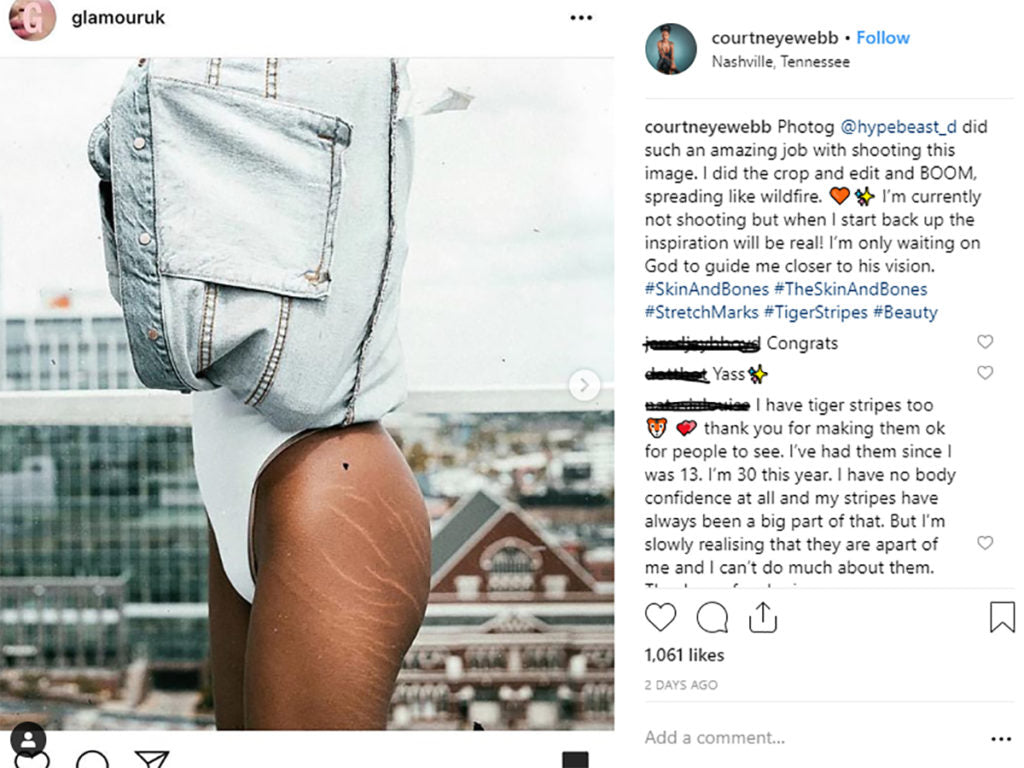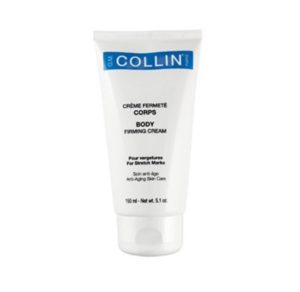What Should You Be Using In Your Skin Care Routine?
Take my quiz and get personalized recommendations from a
licensed esthetician!
The Truth About Stretch Marks
Did you know that over 80% of Americans have stretch marks?

Stretch marks, medically known as “striae distensae,” seem to be having a moment lately.
From brands taking initiatives to stop photoshopping out stretch marks on their models, to rappers crooning about loving a woman with stretch marks, it seems that we can’t seem to forget about them.
Chances are you feel like you can’t keep stretch marks off your hips or off your chest, or maybe off your mind when swimsuit season comes around.
But besides wishing that our stretch marks would at least pay rent if they’re going to permanently live on our tummy, chances are you don’t actually know that much about stretch marks (and you’re not alone).
Maybe part of the acceptance of stretch marks is knowing where they come from, how they can change over time, and how we can lovingly treat them rather than trying to scrub them away with a magical moisturizer that promises us the world.
Well, you’re in luck, because that’s exactly what we’re getting into today!
We’re going to talk all about stretch marks.
From the science behind them to methods for fading them, to the body-positive “stretch mark acceptance” movement that’s been taking pop culture by storm.
Let’s get to it!

Where Do Stretch Marks Come from?
Chances are, you noticed your first stretch marks sometime in your teenage years, post-puberty.
Along with acne, suddenly-smelly underarms, and sprouting body hairs, we also had to deal with some new “tiger stripes” on our bodies – great!
Puberty is one of the most common times for the body to get stretch marks, and that’s because stretch marks occur when the skin of the body is pulled for rapid growth.
Of course, your body has been growing throughout a good portion of your life, so why do we only get stretch marks sometimes?
Well, it’s all about the speed and the amount as to which you grow.
The skin is naturally very elastic, but when it’s over-stretched (meaning too quickly or at too large of a volume at once), your body’s normal collagen production is disrupted and stretch marks may form.
The top layer of your skin (the epidermis) and the second layer of your skin (the dermis) come into play here.
The dermis contains bundles of collagen, which are pulled on when the skin has to stretch too quickly.
These collagen bundles that are pulled tear away from the larger bundle.
When the skin stops growing, these torn collagen bundles are apparent in the epidermis, and voila — now you have stretch marks.
I think it’s safe to say that most of us have gained 10-15 pounds over the span of a year before, and we probably didn’t get stretch marks, because the body can adjust in that time span.
However, if we were to gain 20+ pounds in a month? That’s when you might start seeing some stretch marks.
Because of this, there are two major periods in which women likely will garner some stretch marks: puberty and pregnancy.

In fact, there have been historical artifacts documenting the prevalence of stretch marks (and people trying to get rid of stretch marks), since ancient times.
Ancient Egyptian women had their own special oils that they’d rub on their bellies postpartum in attempts to decrease the appearance of their stretch marks.
Unsurprisingly, the most common areas for women to have stretch marks are around the breasts, buttocks, thighs, and hips (all areas that tend to grow rapidly during both puberty and/or pregnancy).
As I mentioned, anyone who’s ever gone through a period of rapid weight gain will probably also see stretch marks — and that doesn’t necessarily mean fat.
In fact, it’s a common myth that stretch marks are a sign that you need to lose weight — it’s absolutely untrue!
Stretch marks frequently appear on men and women who are bodybuilders because of their rapid growth of muscles, which as you can imagine, causes the skin to majorly stretch.
If you just did a double-take when reading that sentence, here’s a clarification: guys can get stretch marks too!
Because men don’t go through similar bodily processes as women do (re: puberty and pregnancy), they are less likely to get stretch marks, but it’s definitely possible!
In fact, studies estimate that 40% of men will develop stretch marks.
Men most commonly get stretch marks on their upper thighs, their upper arms, their buttocks, and their backs.

But some people, whether male or female, are more likely to develop stretch marks than others.
A major differentiator? How thick your skin is (and I mean literally, not metaphorically).
If you have naturally thicker skin with lots of elasticity, you’re less likely to develop stretch marks.
You also may be more likely to have pronounced stretch marks if you have naturally darker skin, or if you go tanning.
So, if you needed another reason to skip the tanning bed or slather on extra sunscreen before your day at the beach, here it is!
UV exposure can make old stretch marks appear worse (not to mention the slew of other downsides of getting too much sun).
When in doubt, always double up on sunscreen.
Another reason you may see more stretch marks than you expect? Steroid-containing skin creams or Cushing’s Syndrome.
Cushing’s Syndrome is a condition that exposes your body to high levels of cortisone for long periods of time.
You can read more about cortisone and Cushing’s Syndrome here.
Creams such as hydrocortisone, when used for prolonged periods of time, can cause your body to produce stretch marks.
Same goes for people who take oral corticosteroid supplements.
These creams and oral supplements are generally used for allergic reactions and inflammation, as well as for asthma and arthritis.
Stretch marks aside, these types of treatments can have other serious side effects, so be sure to do your own research and listen closely to your doctors prescribing information!

How Stretch Marks Appear Over Time
If you catch your stretch marks in their early stages, you’ll notice them as reddish or purplish lines.
Sometimes they’re indented and you can physically feel them.
Sometimes they are textured in a way that almost looks and feels like scar tissue.
In some people, early stretch marks can even be itchy.
Back to puberty — I remember some friends of mine finding purple lines and freaking out!
But the reason stretch marks appear more colorful in the early stages is because when the collagen tears, blood vessels may also break — making the marks look almost like linear bruising.
But, like me, you’ve probably noticed that stretch marks naturally fade on their own over time — even if you don’t do anything to them.
Eventually, your tiger stripes will fade to a more whitish or clear color, and sometimes they’ll eventually become nearly invisible, or simply just shiny in certain lighting.
While some people claim that treating your stretch marks early on can help get rid of them faster, there’s no concrete evidence on this.
As I mentioned, stretch marks fade naturally, so it’s hard to tell if certain methods are truly working or if it’s simply just time.

Can You Really Get Rid of Your Stretch Marks?
Here’s the bad news first: no matter what you do (or how much money you spend), you’ll likely never be able to completely get rid of your stretch marks.
Some well-marketed creams may tell you otherwise, but doctor after doctor has confirmed that there’s no “cure” for stretch marks.
Here’s the good news: there are some methods to make your stretch marks fade, or simply to make them less noticeable.
How to Make Your Stretch Marks Less Noticeable
Okay, so maybe you can’t ever truly erase your stretch marks, but that doesn’t mean you can’t work to make them less noticeable (or simply cover them up with some good ol’ concealer).
Here are some of my favorite, most effective ways to minimize the appearance of stretch marks.
Topical Treatments
Unfortunately, most topical treatments like Bio-Oil that promise to reduce the appearance of stretch marks can’t actually do any real damage on your tiger stripes.
However, you can certainly give them a try!
StriVectin SD Advanced Intensive Concentrate for Wrinkles & Stretch Marks moisturizes skin while boosting collagen to reduce the appearance of stretch marks.
Moisturizing your skin may help reduce the appearance of your stretch marks temporarily (and help prevent new stretch marks).
This Conditioning Body Butter from Glo Skin Beauty contains sweet almond oil, shea butter, vitamin E, and squalene for beautifully moisturized skin.
GM Collin Firming Cream is also an option to moisturize skin and improve its elasticity, preventing the formation of new stretch marks.
Tinted lotions can help temporarily reduce the appearance of stretch marks too, which is why you may sometimes feel like topical solutions work.
If you want to go the at-home, topical route, I recommend sticking to something organic and natural, like cocoa or shea butter!
My Alana Mitchell Organic MCT Facial Oil is all-natural and multi-use, so you can apply it on your body for all-over moisture.
But at the end of the day, if you really feel like you must get rid of your stretch marks, you probably have to attack the “problem” where it came from — inside your body, not on the surface level!
Sunless Tanner
I’m a big advocate for sunless self-tanner as a substitute for sun exposure, but did you know that it can also help to mask your stretch marks?
Unlike a “real” suntan, which will make your stretch marks more pronounced, a sunless tanner will help to “cover” the stretch marks by applying a color that will help the distinctly colored stretch marks blend with your skin.
I personally love Suntegrity's self-tanner formula.
Coola also offers a long-lasting Sunless Tan Dry Oil Body Mist that's gotten great reviews.
Body Makeup
This may not be the most practical option for day-to-day wear, but if you’re feeling self-conscious about certain marks and want to look your best on special occasions, there’s no reason not to use a little concealer on your body like you would on your face!
Here’s a quick video tutorial on how to cover stretch marks with makeup.
Of course, this probably isn’t your best bet if you’re looking for a poolside solution, but it might be exactly what you need to feel your best for a family photo shoot!
If you want an overall bronzed look, I recommend Image Skincare's Body Spa Face and Body Bronzer.
Laser Treatments
If you really want to eradicate your stretch marks and you have a hefty beauty budget, you may want to consider laser treatments to help fade your stretch marks.
Generally, stretch marks will only require one treatment (although older stretch marks may be more difficult to treat) and will cost you anywhere from $2,000-$6,000.
The lasering process is somewhat similar to microneedling (remember the vampire facial?) and works by traumatizing the skin, which then causes increased collagen production in the area.
Microneedling with PRP
Another microneedling option is microneedling with PRP, which is a platelet-rich-plasma.
PRP is a “growth factor” liquid that is said to help with inflammation and reducing the appearance of wounds.
Anywhere from three to six sessions are recommended, and each session will cost from $1,000-$3,000.
It’s unclear how well this treatment works, and you won’t see results until a few months post-procedure, but you can certainly see a difference when you check before and after photos from women who have tried it.
Just keep in mind that treatments like these can be dangerous, and you should always consult your doctor first.
Increasing Your Collagen
Because collagen is a factor in the creation of stretch marks, some people have hypothesized that upping your collagen levels can help to prevent new stretch marks or fade out old ones.
While I’m a big fan of collagen for its other benefits (such as making your skin look plumper and younger), the jury is still out on if it can truly help with stretch marks.
As you’ve probably heard, many women are adding collagen supplements into their diet, mostly in the form of collagen protein powders or gummies.
However, science has yet to truly back any reported benefits.
Please don’t add supplements into your diet without consulting your doctor first!

Specific Ingredients That Are Said to Treat Stretch Marks
Like I mentioned earlier, there really aren’t a ton of topical solutions that will work to permanently reduce the appearance of stretch marks, but there are a few ingredients that can make a difference (or at least, some people claim they do) — especially if you treat your stretch marks early.
Retinoids
Many doctors swear by retinoids for stretch mark duty.
Here’s why they might be onto something:
You probably know retinoids from your anti-aging products.
That’s because retinol creams are a vitamin-A derived product that work to build collagen.
Retinols work to make those collagen bundles (you know, the ones that we talked about earlier) healthier and thicker.
Just like the retinoids you use on your face, patience is key, and you might experience some dryness initially.
But, with the right prescription retinoid and regular application, you might notice your stretch marks beginning to fade.
Just remember that you shouldn’t use retinol while pregnant, and they don’t work preventatively on stretch marks as they may for wrinkles.
Vitamin E
You probably have already heard great things about vitamin E for treating scar tissue and sunburn.
This is because vitamin E helps to signal the body's cells — alerting them of skin that needs to be repaired.
As an antioxidant, vitamin E can also potentially work as a preventative stretch mark solution by bolstering the collagen fibers and protecting them from free radicals.

Credit: glamouruk & courtneyewebb
Embracing Them: the Stretch Mark Positivity Movement
At the end of the day, stretch marks are a part of what makes you, you.
It’s easy to gaze longingly at a swimsuit ad and wish we had perfect skin like the model, but it’s also easy to forget that a lot of photoshopping went into that ad — which is why many brands are pushing back against heavy photoshopping.
In fact, brands like ASOS, Target, and Aerie have vowed to quit photoshopping out the natural (and beautiful) stretch marks on their models.
Even Victoria’s Secret, notorious for giving girls (& women) unrealistic #bodygoals, dabbled in the photoshop-free movement by releasing an ad with stretch marks as a lovely accessory to their Fantasy Bra.
I know what you’re thinking — “Okay, Alana, I would be comfortable with my stretch marks if I had the body of a Victoria’s Secret model” — and I totally get that!
Brands still have a long way to go in terms of representing real women wearing their products, but this baby step into the stretch marks acceptance movement is still a win in my eyes!
And it’s seemingly having a ripple effect.
Real women like you and I have been taking to social media to proudly display our stretch marks — because who said they were something to be ashamed of?
In 2017, supermodel Chrissy Teigen hopped on the #loveyourlines train and took to Twitter to show her stretch mark acceptance.

Other hashtags like #thighreading and #effyourbeautystandards also work to remind us all that self-love starts within.
After all, what makes us want to cover up our stretch marks in the first place?
Sometimes it almost seems like the “decision” that stretch marks were “bad” is just another idea meant to make women feel bad about what makes us women — or simply to sell us more products we don’t need.
If you’re still not sold on the idea that your stretch marks are nothing to be ashamed of, may I recommend listening to Kendrick Lamar’s “Humble?”
Here’s the line (from the clean version) that got the Internet buzzing:
“Show me somethin' natural I wanna feel some stretch marks.”
Final Thoughts
You’re beautiful — and so are your stretch marks.
While I believe that learning to accept your “tiger stripes” is the way to go (especially since there are no guaranteed methods for erasing them completely), I also understand that every person has their own insecurities.
I hope you’ve found some useful information in this blog post!
Whether that means you’re going to join the women on social media who #lovetheirlines, or you’re going to save up for some laser treatment — you go, girl!
Beauties, how did you come to love and accept your stretch marks? Have you ever tried any remedies to get rid of them? How do you feel about the stretch mark positivity movement? I’d love to read your comments!
3 comments
I have suffered for so long about my stretch mark i ask my self why this happens to people but at the same time i think and i thank god just for having me here and forget about them but i always got someone staring at me or laughing when i take off my shirt and it just hirts that it going to be there for life cause theres no way i have tried so many different things and nothing works i just gave up🥺🥺🥺💯
It was really interesting to learn that vitamin E can potentially work as a preventative stretch mark solution because I never knew that, and I wish I had before getting pregnant. Right now I am 7 months pregnant and I am really worried about having my body get back to normal after I have my baby girl. I love fitness and health, and I am trying to find a cream or an option that will help me get rid of and heal my pregnancy stretch marks, so these tips have been really helpful.
I got dermalmd stretch mark serum for my 14 years old daughter, she has some stretch marks in her legs and it works. You won’t see results in one week but after 4 weeks really works perfectly.























